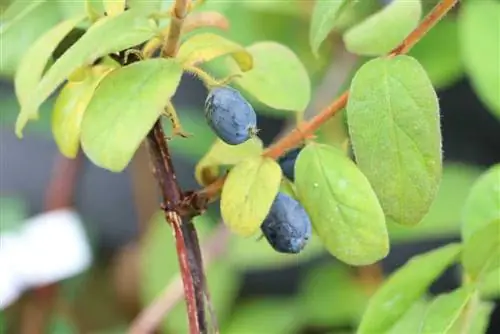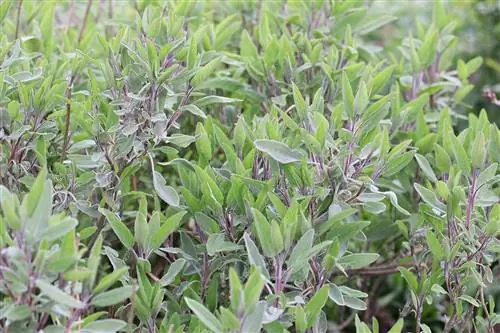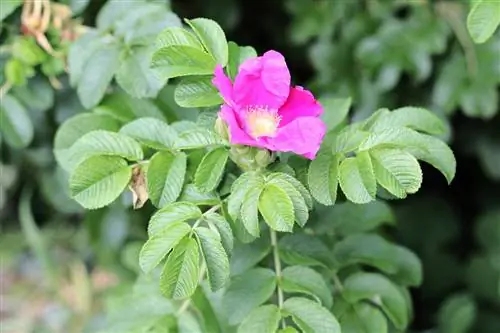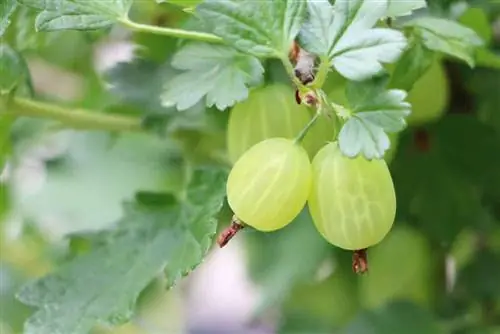- Author admin [email protected].
- Public 2023-12-17 03:39.
- Last modified 2025-01-24 12:45.
The Mayberry is an easy-care, summer-green berry bush. Today it is mainly grown as an ornamental shrub, but the fruits, which ripen in May, taste very good and can be eaten raw. They are reminiscent of cultivated blueberries in color and taste and are very rich in vitamins. Garden owners appreciate the easy-care plant and can look forward to the bell-shaped, yellowish-white flowers from March onwards. As a very attractive eye-catcher in the garden, the mayberry requires little care and impresses with its frugality and robustness.
Family and origins
The plant originally comes from the eastern part of Siberia, and its botanical name is derived from the Kamchatka region (Lonicera kamtschatica). There it grows mainly in mountain forests and alpine areas. The Mayberry - also called honeyberry, Kamchatka honeysuckle or Siberian blueberry - belongs to the honeysuckle family.
Flowers, leaves and berries
Just a few warm winter days cause budding to begin. The bell-shaped flowers, about two centimeters in size, form in pairs and welcome spring with their honeysuckle scent.
Only after the flowers do the approximately 5 to 6 cm long leaves of the ornamental shrub grow. Its light, velvety hairiness, which can be found on both sides of the leaves, is characteristic. The leaves are shed very early, well before autumn; this often happens at the end of August. The first vitamin-rich fruits can be harvested as early as May, well before many other types of berries. The Siberian blueberry is similar to the cultivated blueberry in its growth and the taste of the fruits, but the blue berries of the Mayberry differ significantly in their elongated shape. The plant offers a slightly lower berry yield than the blueberry, but to compensate for this it is also much less demanding.
Planting and location
- The growth height of the shrub is usually around 1 meter, but the honeyberry can grow up to 1.5 meters high after several years. For this reason, it should not be chosen as an underplant for other shrubs.
- It can be planted all year round, but planting in spring is ideal. Planting in autumn will also lead to the desired success. However, it is always important that there should be no frost.
- Since the plant does not place high demands on soil conditions, it thrives in normal garden soil without any problems. Neither a bog bed nor a special pH value or other preparation of the soil is necessary.
- The shrub prefers moist and bright locations, but it also tolerates partial shade or direct sun very well. A bright and sunny place is always the best choice for the berry yield.
- Before planting, the root ball should be loosened slightly and the individual roots carefully plucked apart.
- Drought should be avoided at all costs as the plant does not tolerate it well. It is therefore advisable to water regularly during dry periods.
- It is also ideal as a potted plant for terraces and balconies and offers an attractive eye-catcher. Due to their frost resistance, the potted plants can also overwinter outdoors without any problems.
- Lilies of the valley are considered ideal plant neighbors because they offer a very beautiful color contrast. An increase in crop yield was also observed here. In groups with other berry bushes such as gooseberries or cultivated blueberries, they complete the garden picture.
- The most famous varieties are Morena, Maistar, Mailon, Amur and Fialka.
Tip:
It is recommended to always plant 3 or more mayberries - if possible of at least two different varieties - as this improves fertilization and significantly increases the fruit yield.
Care and cutting
- If the plant is cut regularly, it will reward you with a long lifespan and rich yield.
- In spring you should fertilize with special berry fertilizer. This promotes more lush flowering and ensures a higher yield.
- The ideal time for pruning is immediately after the fruit has been harvested.
- Shoots that are too dense and older should be cut off as close to the ground as possible. The shoots, which are around 2 years old, can be easily recognized by their barky bark.
- After cutting, around 8-10 shoots should remain. If the plant has too many and too dense shoots, the quality of the fruit suffers.
- At a height of approx. 3 cm, soil should be piled up around the bush, as this promotes the formation of new young shoots.
Propagation
The honeyberry can be easily propagated by cuttings. In June, after harvesting, shoots about 20 cm long are cut and then planted in pots with loose substrate. It is important to water the small plants regularly; the soil must not dry out under any circumstances. In the fall, place the plants in a cool, bright room to overwinter. Now you have to make sure to water a little less - the cuttings must not be kept too wet or too dry. The following spring the small Mayberries can be planted in the garden.
Wintering, diseases and pests
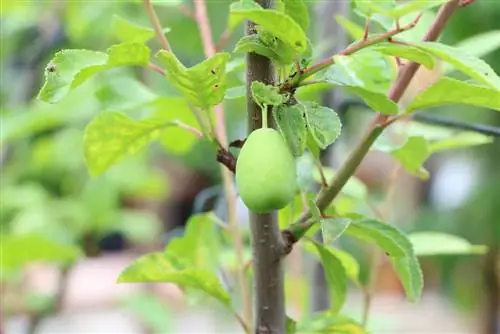
The approximately 2 cm long flowers appear in March before the leaves and are frost-proof down to around -8 °C. Due to its Siberian origins, the plant itself can easily tolerate temperatures down to around -45 °C. There is no need for special winter protection for the easy-care Mayberry in our latitudes; it can survive even very harsh winters without any problems. Due to its robustness, it is a welcome ornamental shrub for many garden owners. It is not susceptible to disease and is largely spared from pests. Only occasional infestations by frostbite moths could be observed. The fruits are very popular with the bird world, much to the chagrin of many garden owners, so in bird-rich areas the bushes may need to be covered with bird netting to protect the berries. Otherwise it may happen that there is not a single berry left for a harvest.
Frequently asked questions
At what distance should the individual mayberry bushes be planted?
A single plant takes up around 1 m² of space. A planting distance of at least one meter should therefore be maintained in order to give the respective shrub enough space to spread.
When can you expect the first fruits to be harvested after planting?
The plant initially needs a certain amount of time to grow. It usually takes at least 3 years before the first harvest of the delicious May berries can take place.
What you should know about the mayberry in brief
- The Mayberry is a shrub that can grow to around 1 to 2 meters high. Its fruits ripen in May to June and are edible.
- The plant comes from Siberia, Kamchatka and is at home on the Kuril Islands.
- The mayberry is rarely used for fruit production, although the berries are edible and contain pectins, vitamins and other he althy ingredients.
- The Mayberries bloom in March and can tolerate temperatures down to -8 °C. The flowers appear before the leaves.
- Also available are two quite similar varieties ‘Maistar’ and the slightly later ripening ‘Mailon’. Their fruits are tastier.
Location
- The Mayberry should have a sunny to light shade location. She doesn't like it too warm. It is therefore better to avoid the blazing midday sun.
- Ideal companion plants for the berry bushes are healing lilies of the valley. They increase the productivity of the bushes.
- You should plant at least two bushes so that they can cross-pollinate. Different varieties are ideal for this.
- The planting distance should be about one meter.
Planting substrate
- The Mayberry likes fresh to moist, acidic to neutral, sandy-humus, gravelly or rocky, shallow soils.
- Normal garden soil is usually suitable for use in the garden, as long as it is not too nutrient-poor.
- It shouldn't be too chalky either. You don't have to create a special moor bed for the plants.
Watering and fertilizing
- During hot periods, the mayberry must be watered thoroughly. Otherwise she is quite frugal. However, the plant substrate must not dry out.
- Fertilization is carried out with berry fruit fertilizer in spring.
Wintering
The Mayberry is hardy down to -40 °C. Winter protection is not required
Cutting
- The mayberry is cut similarly to the cultivated blueberry.
- The two-year-old shoots, which can be recognized by their bark, are cut off at the base.
- The best time for this is directly after the harvest. Each plant should then still have 8 to 10 shoots.
Propagation
You can propagate the mayberry through cuttings
Diseases and pests
- The mayberry is very robust. Diseases almost never occur.
- They are also spared from pests.

